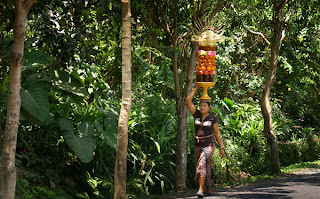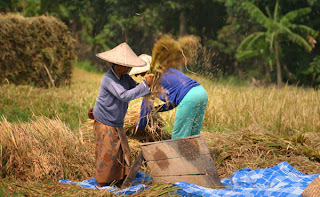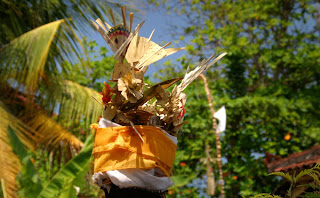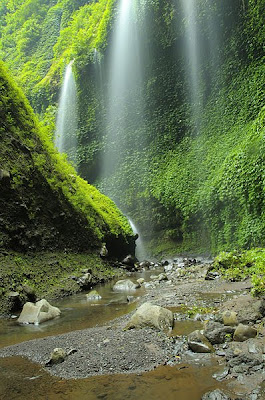aspect of life. The influence of Hinduism the main religion is evident in the music, drama, art, costumes and festivals which take place daily.
You'll encounter a festival almost every day, celebrating the cycle of birth, death and rebirth. Anthropologists believe that the Balinese are descended from the ancient Chinese, the Indians and Arabs from the west, and others who came to the island directly or via Java.
The Bali Aga (The Original Balinese)
The original Balinese or Bali Aga, are a unique ethnic group that still live and practise a way of life that pre-dates modern civilisation. The Bali Aga are thought to be the original inhabitants of Bali who fled imperialistic invaders, eventually finding refuge in the solitude of Bali's remote mountains. Only two villages remain - which until recently, were firmly shut away from the rest of the world, hidden in the hills of East Bali.

Located just west of Candi Dasa lie the villages of Tenganan and Trunyan, isolated across the vast Lake Kintamani. The villages, home to the Bali Aga, are shut off by a solid wall surrounding the entire village. The wall is only broken by means of four gates, each facing north, south, east and west. Within these walls lies a massive Banyan tree surrounded by a low wall of uncut stones, making up a small enclosure for a very sacred temple. Tenganan has only recently opened up to outsiders although strict rules still apply, especially concerning marriage to outsiders. Tenganan has wonderful fabrics, including the renowned double weave ikat cloth.

The villagers of Tenganan are tall and slender with very pale complexions and refined manners. The men folk still wear their hair long and have a communistic system which does not recognize individual ownership of property. Every house in Tenganan looks exactly alike, with a flight of steps leading to a small gate opening into a courtyard with sleeping quarters, kitchen, and a long house for storage. A small empty shrine, signifies a place where spirits may rest when they visit their descendants. Tenganan owns huge tracts of fertile and well cultivated lands capable of satisfying the needs of the village; and also making Tenganan one of the richest in Bali.
A people known for their filed and blackened teeth, the Bali Aga are said to bring the spirits of their ancestors down to Earth for protection through sacrifices. The Bali Aga leave the bodies of their dead in the jungle to be carried away by the spirits, and they are believed to have possibly eaten parts of their headmen's bodies to absorb magic powers. Family clans are ruled by a council of elders who are also religious priests. The Bali Aga revere the forces of nature and the spirits of their ancestors, with whom they continue to live as a great family of both the living and the dead.
Bali Aga Rites

The Tenganans practice an ancient rite known as mekare kare, the ritual blood sacrifice. This is not as gory as it sounds, but an event where all villagers get involved in an annual ritual combat, using thorny pandan leaves to draw blood.
Each combatant hits his opponent with the aim of drawing blood. The ritual fight will be held every time there is a temple ceremony is Tenganan, which tends to fall in the fifth month of the Balinese calendar.
The fighting and the blood are real, and all participants come well prepared, carrying weapons of a rotan-woven shield and a bundle of thorny pandan leaves, used to scratch the opponent's skin until it bleeds.
Before the fight begins, participants drink rice wine or tuak, fermented local palm, to symbolise brotherhood and sportsmanship. But when the selonding music fills the air, a volley of fierce jeers, insults, cheers and shouts are thrown to instill fear. And the fighting begins.
The fighting is judged by a mediator, most probably a prominent figure of the village, and usually lasts for a fierce 5 to 10 minutes. The first person to draw blood with the thorny weapon is victor, and the person he draws blood from is the vanquished. Both victor and vanquished are broken up by the mediator as soon as blood is drawn.
As the injured are treated with traditional liquid medicines, and all fighters recover their strength, the whole village prepares food and drink for an elaborate feast which must follow the Balinese sacrifice of human blood.
Balinese culture has also got a population control mechanism in their child naming practices, and this is not only confined to the Bali Aga, but encompasses every Balinese. Every first born is named Wayan, second born Made, third Nyoman, and the fourth Ketut. Anymore children will see a repeat of the names following the order. But this practice definitely is a big hint and subtle reminder to stop at a maximum of four!
Balinese Religion
Nearly everything in Bali carries a religious significance from creating stone and wood carvings, cremation ceremonies, trance dances and gamelan music, are intended to please and appease the gods.

As most pleasing and appeasing rituals take place in a temple, temples are, undisputedly, the most important structure in Balinese culture, providing a pleasant resting place for the gods during their stay on the island.
Every house on the island has its own shrine, a resting place for ancestral spirits. Even the paddy fields have a shrine for Dewi Sri, the Rice Goddess. Each village has three temples, the Pura Puseh, dedicated to the villagers' ancestors, the Pura Desa, used for official celebrations, and the Pura Dalem or the temple of death, specially dedicated to the deities of death and of cremation.
Cremation Ceremonies
The Ngaben or Cremation Ceremony is a very important part of Balinese culture. The ceremony is performed to send the dead from death to the next life. When death descends on a Balinese, the village kul kul will sound, hanging in the village temple tower to announce the departure of the deceased.
The body will then be placed at the Bale Delod, and the deceased treated as if sleeping. No tears are shed as the Balinese believe that the deceased will return shortly to be reincarnated into the family.
The Priest will then consult the Dewasa for the day of the ngaben ceremony. On the appointed day, the body of the deceased is placed inside a coffin, which is then placed inside a wadah, or sarcophagus shaped in the form of a buffalo. It is actually a temple structure made of paper and light wood.
The funeral procession then leaves for the cremation site, carrying the wadah. The most important part of the ngaben is the burning of the wadah, with fire taken from a holy source, thus sending the deceased to the afterlife,to prepare for a future reincarnation.
 Bali is known with a view not only beautiful but also delicious cuisine shake up the tongue. Satay wrap is one of Bali's most popular dish. Lemongrass scent and taste the sweet savory taste delicious lunch is guaranteed to add this time!
Bali is known with a view not only beautiful but also delicious cuisine shake up the tongue. Satay wrap is one of Bali's most popular dish. Lemongrass scent and taste the sweet savory taste delicious lunch is guaranteed to add this time!

 10:19 PM
10:19 PM
 Santi Utami
, Posted in
Santi Utami
, Posted in





















